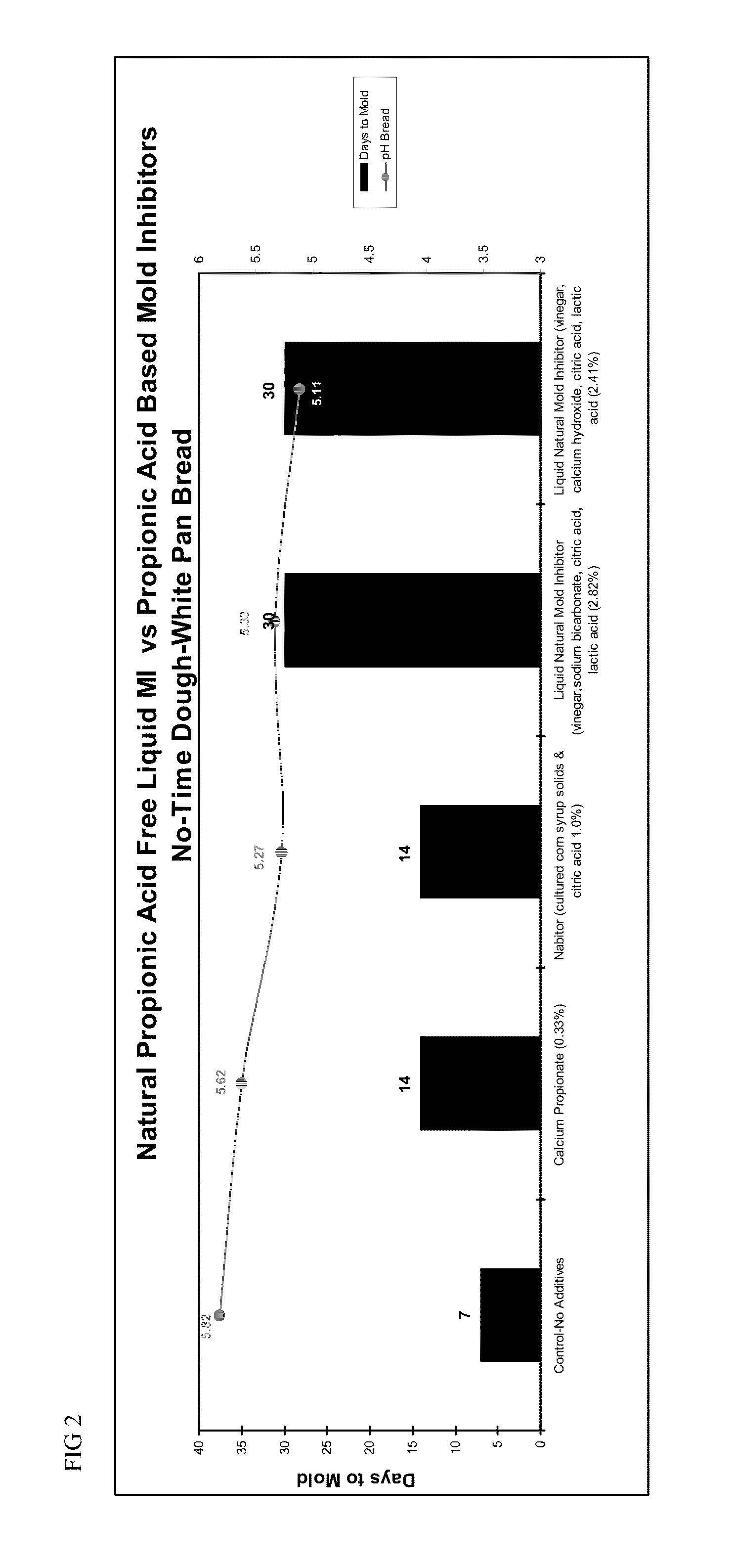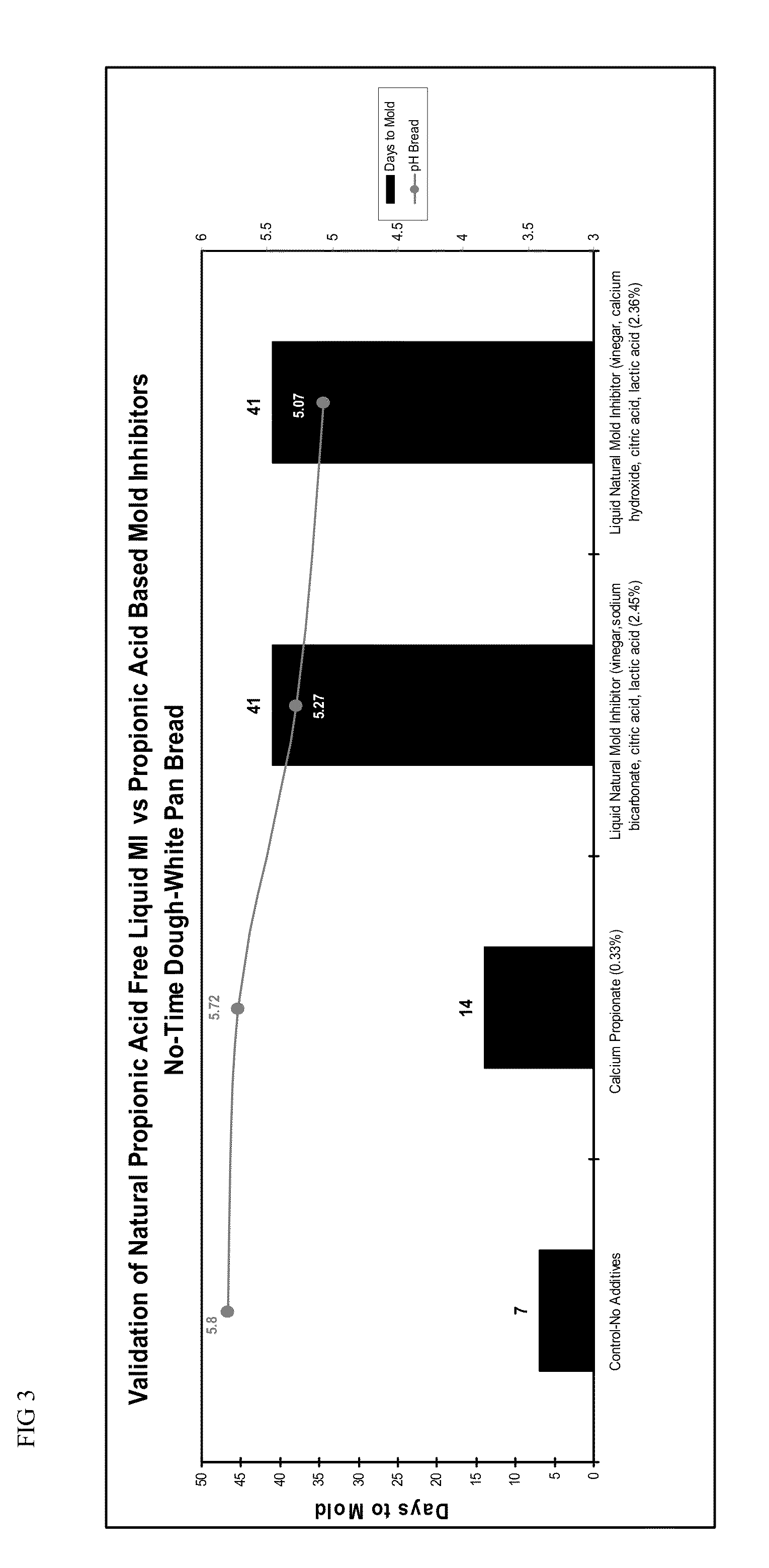Natural Mold Inhibitor and Methods of Using Same
a mold and natural technology, applied in the field of natural mold inhibitors, can solve the problems of limiting the shelf life of baked goods, microbial spoilage has now become the limiting factor, and the current effective mold inhibition system for yeast raised baked products is not effective, so as to prolong the shelf life of baked products and inhibit mold growth
- Summary
- Abstract
- Description
- Claims
- Application Information
AI Technical Summary
Benefits of technology
Problems solved by technology
Method used
Image
Examples
example 1
Manufacture of Solid Mold Inhibitor
[0055]11-22 grams of sodium bicarbonate or calcium hydroxide is combined with 78-89.0 grams of 200 grain liquid vinegar. The liquid mixture is then agitated by an agitator and heated to a temperature of about 110 F for 30 minutes to form a solution of solids with a solids level of from about 10% to about 40% total solids. The solution is then processed to remove water to achieve less than about 10% moisture. Removal of water may be achieved using a spray dryer, though other methods known in the art may be used. The dry material is then combined with a natural organic acid such as citric acid at a ratio of about 70% dry material to about 30% acid. The final material is blended and then packaged.
example 2
Manufacture of Liquid Mold Inhibitor
[0056]9-16 grams of sodium bicarbonate or calcium hydroxide are combined with 83-91 grams of vinegar having a strength of about 200 to about 300 grain. The liquid mixture is then agitated using an agitator and heated to a temperature of about 110 F for 30 minutes. Following agitation with heating, the pH is checked and is from about pH 4.0 to about pH 5.5. The material is then packaged.
TABLE 1Dry Mold Inhibitor Formulations (Amounts provided asweight %)IngredientEx 3Ex 4Ex 5Ex 6Ex 7Ex 8Ex 9Ex 10Sodium15.016.52527.5Bicarbonate1Calcium7.78.251719hydroxide2Vinegar, 20055.062.358.566.75grain3Vinegar, 300455347.556grain4Citric acid53030252530302525
TABLE 2Liquid Mold Inhibitor Formulations (Amounts provided as weight %)IngredientEx 11Ex 12Ex 13Ex 14Sodium1616Bicarbonate1Calcium9.259.25hydroxide2Vinegar, 20083.9590.7grain3Vinegar, 30055.9559.95grain4Cultured0.050.050.050.05Wheat6Water2830.751Commercially available from Vitusa Products, Inc2Commercially a...
example 15
[0057]Bread is prepared using the no-time, straight dough method by mixing the following ingredients in a Hobart A200 mixer with a McDuffy attachment for a total of 8 minutes until full gluten development is obtained: flour (100%), water (68%), granulated sugar (7%), shortening (4%), fresh yeast (2.5%), 30% acetic acid vinegar or 300 grain vinegar (0%, 2%, 1% or 0.5%), and citric acid (0% or 0.1%). Mixed dough is rested for 10 minutes on bench then scaled into two 520 gram dough pieces and rounded by hand. Rounded dough is rested 10 minutes then is sheeted and molded into logs. Sheeted and molded logs are placed into oiled bread pans and placed into proof box (National Manufacturing) and set to 110° F. and 80% relative humidity. Dough is proofed to a consistent height, as measured by a template which was 0.75 inches above the rim of the bread pan. Proof time is considered to be time for dough to touch the top of the template minus initial time in the proof box. Proofed dough is then...
PUM
| Property | Measurement | Unit |
|---|---|---|
| weight | aaaaa | aaaaa |
| temperature | aaaaa | aaaaa |
| temperature | aaaaa | aaaaa |
Abstract
Description
Claims
Application Information
 Login to View More
Login to View More - R&D
- Intellectual Property
- Life Sciences
- Materials
- Tech Scout
- Unparalleled Data Quality
- Higher Quality Content
- 60% Fewer Hallucinations
Browse by: Latest US Patents, China's latest patents, Technical Efficacy Thesaurus, Application Domain, Technology Topic, Popular Technical Reports.
© 2025 PatSnap. All rights reserved.Legal|Privacy policy|Modern Slavery Act Transparency Statement|Sitemap|About US| Contact US: help@patsnap.com



